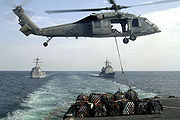
VERTREP
Encyclopedia


Underway replenishment
Underway replenishment or replenishment at sea is a method of transferring fuel, munitions, and stores from one ship to another while under way.-History:...
by helicopter
Helicopter
A helicopter is a type of rotorcraft in which lift and thrust are supplied by one or more engine-driven rotors. This allows the helicopter to take off and land vertically, to hover, and to fly forwards, backwards, and laterally...
. The United States Department of Defense
United States Department of Defense
The United States Department of Defense is the U.S...
defines VERTREP as:
- ...the transfer of cargo between ships using helicopters. VERTREP is often used to supplement connected replenishment. Weapons loads, generally limited to 4,000 pounds, are transferred from the supply ship to the flight deck of the amphibious ship. The decided advantage of a VERTREP is that it can effect replenishment without ship-to-ship connection.
History
The United States Navy Sixth Fleet had developed VERTREP routines in 1957 with SH-3 Sea King helicopters operating from USS Mississinewa (AO-144)USS Mississinewa (AO-144)
|- See also :* List of United States Navy ships...
and USS Altair (AKS-32). Each ship carried one SH-3. At that time, there was some anticipation that nuclear-powered ships might reduce the need for alongside refueling. Altair performed the first night VERTREP to an aircraft carrier in 1965.
Modern United States Navy VERTREP procedures were initiated from USS Sacramento (AOE-1)
USS Sacramento (AOE-1)
USS Sacramento was the third ship in the United States Navy to bear the name, for both the Sacramento River and the capital city of California...
in November 1964. Sacramento embarked two CH-46 Sea Knight
CH-46 Sea Knight
The Boeing Vertol CH-46 Sea Knight is a medium-lift tandem rotor transport helicopter, used by the United States Marine Corps to provide all-weather, day-or-night assault transport of combat troops, supplies and equipment. Assault Support is its primary function, and the movement of supplies and...
helicopters to enable simultaneous transfer of ammunition by helicopter while petroleum fuels were pumped through conventional alongside hose connections. Ammunition could be delivered to other ships up to 100 miles from Sacramento. Receiving ships have greater freedom of maneuver during VERTREP than conventional alongside transfers; and time loss is minimal in comparison to maneuvering alongside and rigging transfer lines. One Cold War
Cold War
The Cold War was the continuing state from roughly 1946 to 1991 of political conflict, military tension, proxy wars, and economic competition between the Communist World—primarily the Soviet Union and its satellite states and allies—and the powers of the Western world, primarily the United States...
VERTREP was accomplished while the receiving United States destroyer maintained contact with a Soviet submarine.
Transfer Methods
VERTREP helicopters are equipped with a cargo hook from which may be suspended either special ordnance slings or conventional cargo nets for less sensitive loads. A normal load is two to four pallets, depending on weight. The load is placed in position on the deck of the receiving ship by lowering the helicopter slowly from a high hover, and the load can be released manually by a helicopter crewman positioned to watch the load.Rate of Transfer
Ships without large flight decks or support equipment like forklifts are often unable to break down palleted loads and transfer them off of the receiving deck as rapidly as the helicopter can deliver another load. VERTREP supply ships carrying more than one helicopter can simultaneously make deliveries to several ships of a task group. Food can be handled somewhat faster than munitions because of the reduced safety considerations.Limitations
Lift capabilities of helicopters are reduced by adverse wind conditions or high temperature or humidity. Pre-loading of pallets is necessary for rapid transfer, and requires advance knowledge of weather conditions and special care to secure light items which may otherwise be blown out of containers. While popular in use, VERTREP is considered relatively dangerous (as compared to other replenishment methods) as it involves danger to the loading personnel due to the helicopter and the load, and in turn, potential risks to the helicopter due to Foreign Object Damage (FOD)Foreign object damage
Foreign Object Debris is a substance, debris or article alien to a vehicle or system which would potentially cause damage.Foreign Object Damage is any damage attributed to a foreign object that can be expressed in physical or economic terms that may or may not degrade the product's required...
.
See also
- Aerial refuelingAerial refuelingAerial refueling, also called air refueling, in-flight refueling , air-to-air refueling or tanking, is the process of transferring fuel from one aircraft to another during flight....
- Carrier onboard deliveryCarrier onboard deliveryCarrier Onboard Delivery is a military term used to describe type of aircraft which are able to ferry personnel, mail, and high-priority cargo on and off a naval ship .-History:...
- Military logisticsMilitary logisticsMilitary logistics is the discipline of planning and carrying out the movement and maintenance of military forces. In its most comprehensive sense, it is those aspects or military operations that deal with:...
- Underway replenishmentUnderway replenishmentUnderway replenishment or replenishment at sea is a method of transferring fuel, munitions, and stores from one ship to another while under way.-History:...

